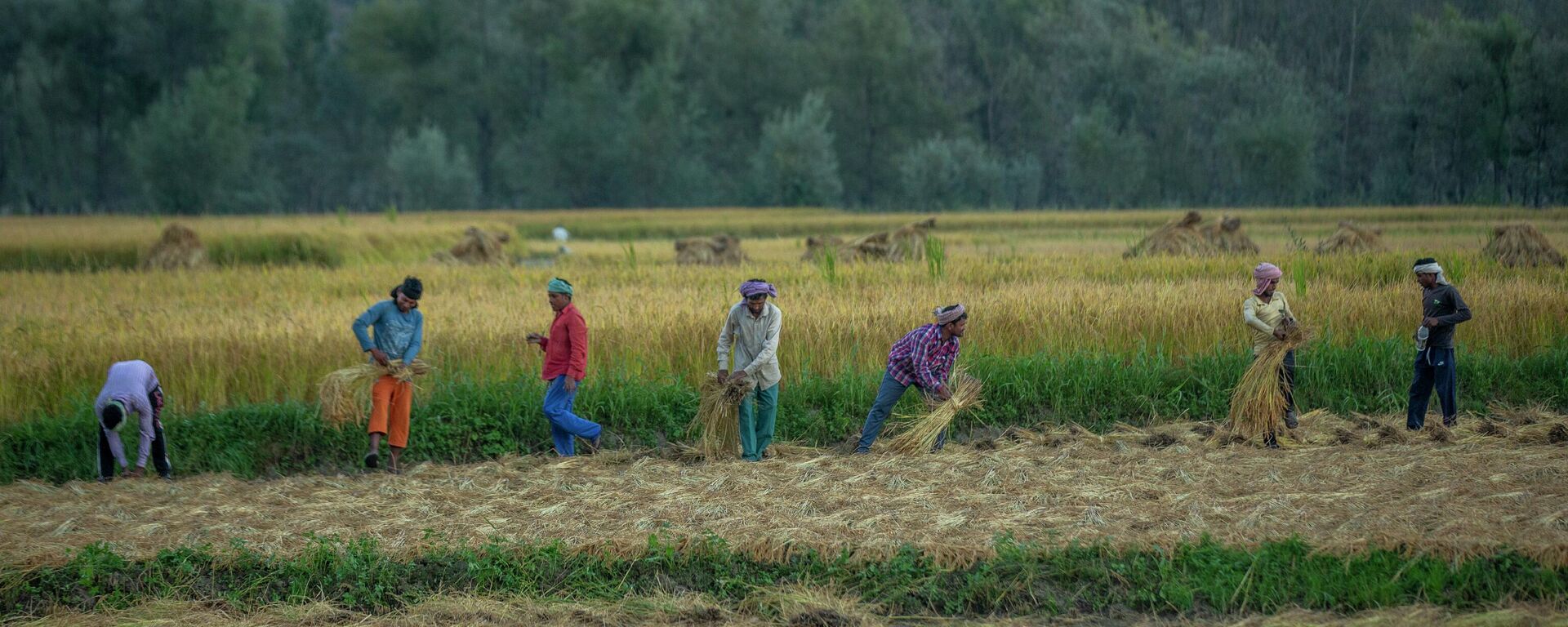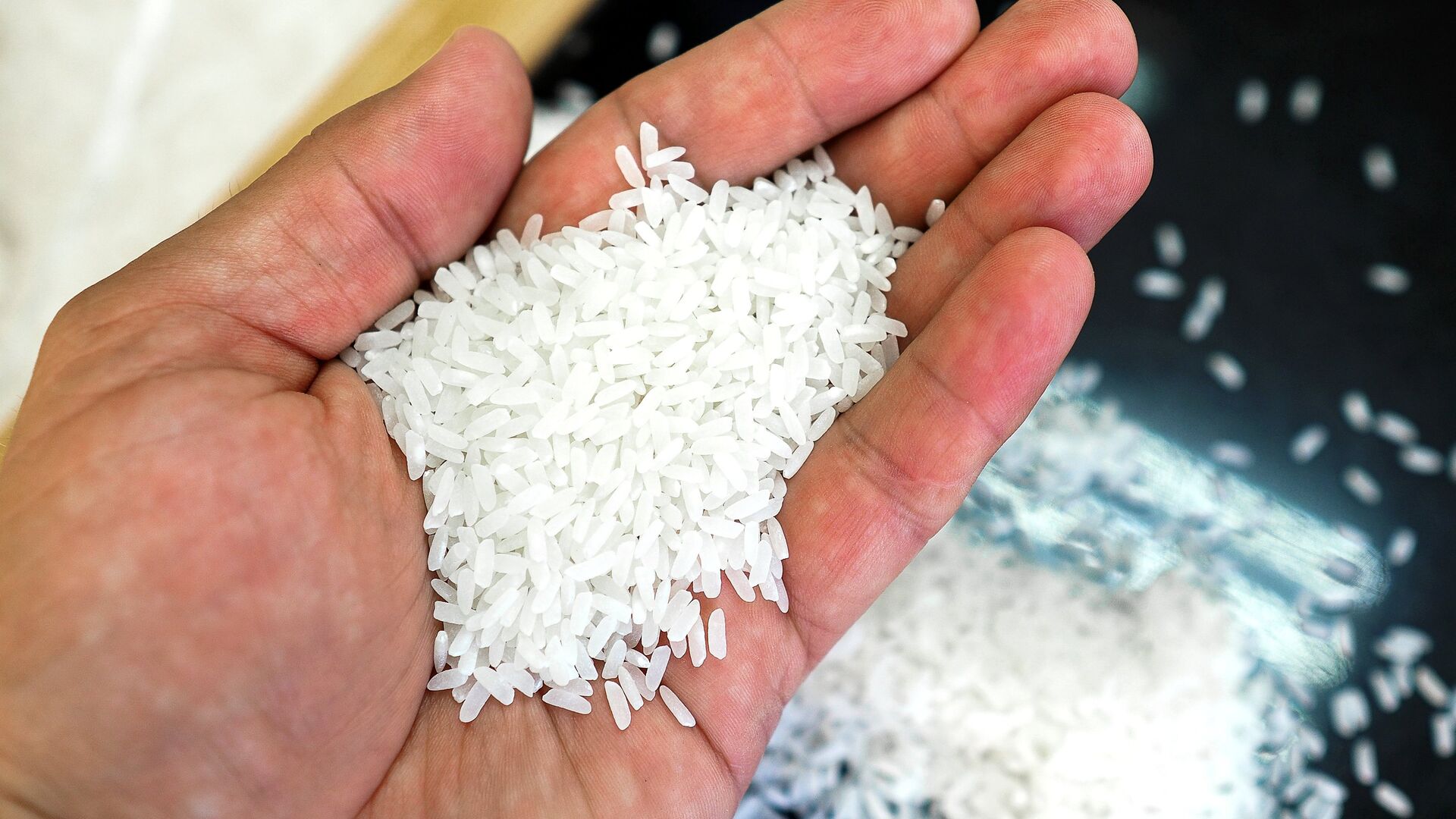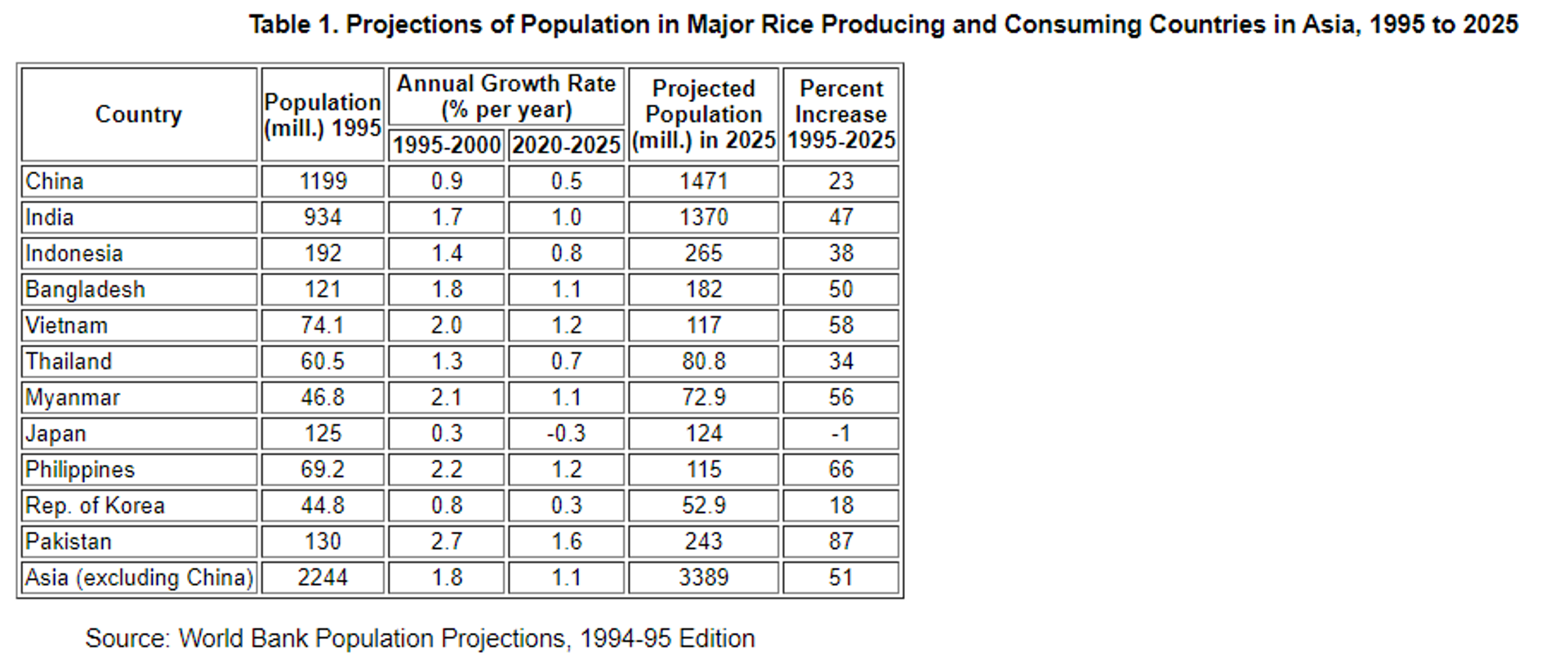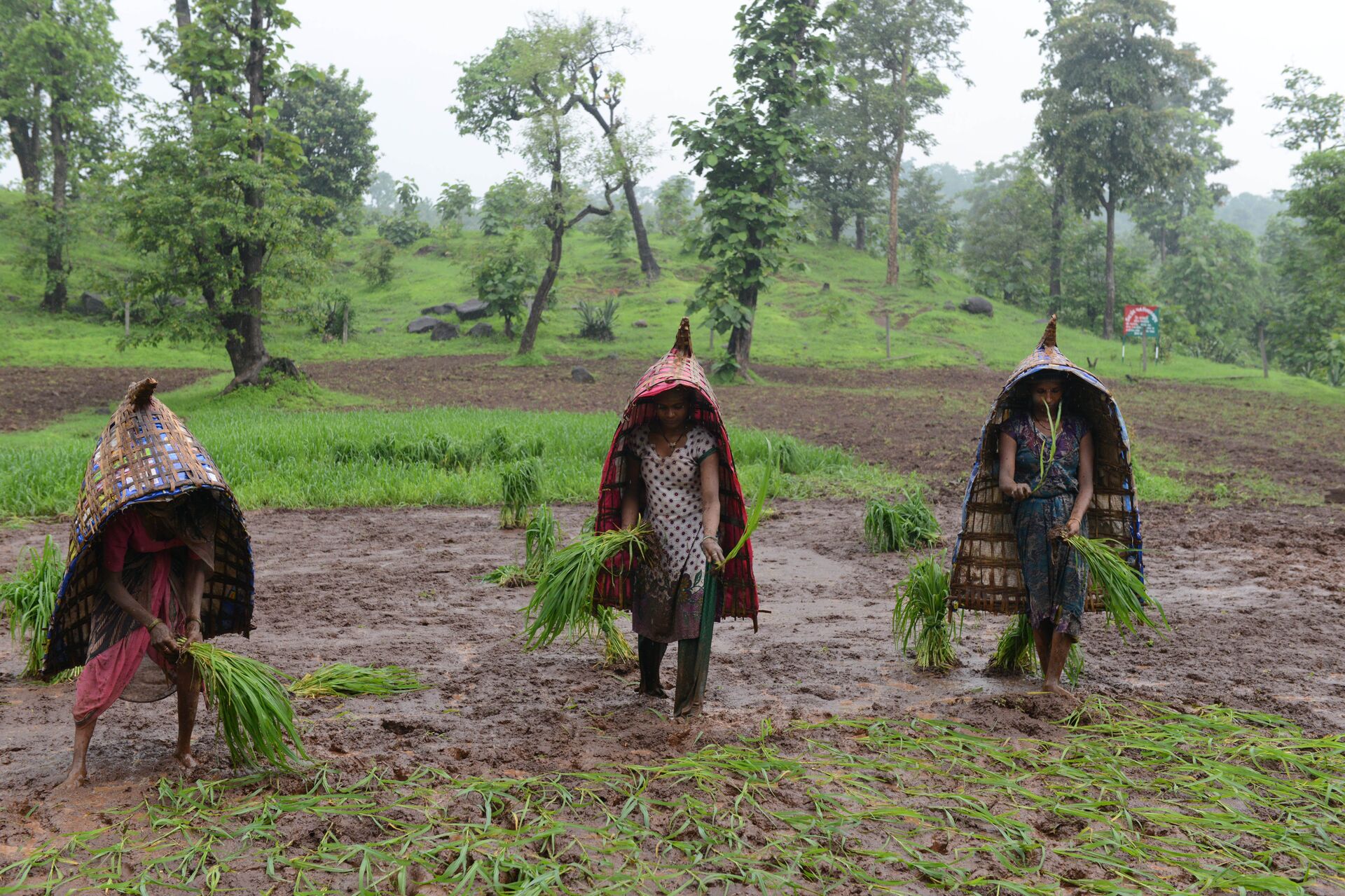https://sputnikglobe.com/20230419/looming-global-rice-deficit-in-2023-will-be-largest-in-20-years-result-in-decade-high-costs-1109646164.html
Looming Global Rice Deficit in 2023 'Will Be Largest in 20 Years', Result in 'Decade-High Costs'
Looming Global Rice Deficit in 2023 'Will Be Largest in 20 Years', Result in 'Decade-High Costs'
Sputnik International
In 2023, the world will be facing the largest global rice deficit in twenty years, according to a media-cited report by Fitch Solutions Country Risk & Industry Research.
2023-04-19T10:39+0000
2023-04-19T10:39+0000
2023-04-19T10:39+0000
rice
shortage
china
pakistan
weather
floods
heat wave
economy
https://cdn1.img.sputnikglobe.com/img/106921/35/1069213545_0:153:3099:1896_1920x0_80_0_0_1dc5ea96946da09a1c633ee2707b9507.jpg
The world will face the largest global rice deficit in 20 years in 2023, according to a report by Fitch Solutions Country Risk & Industry Research, cited by the media.The projected shortfall has been caused by plummeting rice production, and the inevitable result will be surging prices, with a vast part of the global population affected, it warned.The rice deficit for 2022/2023 is estimated at around 8.7 million tons, the report forecast. The last time there was such a dire shortfall of the globally popular staple was in 2003/2004, when there was a deficit of 18.6 million tons on the global markets.The price of rice, on average, was $17.30 per hundredweight (approximately 45kg) throughout 2023, the report added although it forecast that the price would drop to $14.50 per hundredweight in 2024.The global rice deficit will, "increase the cost of importing rice for major rice importers such as Indonesia, Philippines, Malaysia and countries in Africa in 2023," Oscar Tjakra, senior analyst at global food and agriculture bank Rabobank, was cited as saying.Weather & GeopoliticsOver 90 percent of the world’s rice is produced and consumed in the Asia-Pacific region. However, last year bad weather affected the production on a mass scale.China, the world's largest rice producer, saw its major production areas such as Guangxi and Guangdong provinces inundated by particularly heavy monsoons last year, which resulted in floods. Meanwhile, severe drought affected Jiangsu province, China’s fourth-largest rice-producing region. China's rice exports primarily go to the Philippines, South Korea and Japan.There has also been a shortage of rain in India, and monsoon floods in Pakistan, which accounts for 7.6 percent of the global rice trade. All these factors combined to threaten global supplies of the commodity.The shortfall can be explained, in part, by “an annual deterioration in the mainland Chinese harvest caused by intense heat and drought as well as the affect of severe flooding in Pakistan,” the report stated. Some of the leading European rice-growing countries - France, Germany and the UK - have also been tackling the highest level of drought in around 20 years, media reports cited Kelly Goughary, senior research analyst at Gro Intelligence, as saying.But the present predicted supply challenges have not been caused by weather alone. Demand in rice, the report claimed, had been driven up as it was deemed an attractive alternative after the surge in other grain costs caused by the Ukraine crisis.Furthermore, India, which exports rice to more than 150 countries, accounting for nearly 40 percent of global exports of the grain, moved to limit rice exports as domestic prices surged. According to industry estimates, paddy sowing during the 2022 season had been 6 percent lower than the year before because of a shortage of rains in eastern parts of the country, resulting in higher prices in the domestic market.'Solid Rebound Ahead'Fitch Solutions estimates that the global rice market will return to “an almost balanced position in 2023/24.”“We believe that the rice market will return to surplus in 2024/25 and then continue to loosen through the medium term,” the report stated. Prices were, accordingly, anticipated to lower by around 10 percent to reach $15.50 per hundredweight in 2024.For the coming five-year period, the analysis estimated that India would be the "principal engine" of growing global rice production. Nevertheless, crops will still probably be at the mercy of the vagaries of the weather, as there are still forecasts of heatwaves through the second and third quarters of 2023, the report warned.
https://sputnikglobe.com/20220909/india-limits-rice-exports-over-production-concerns-as-domestic-prices-soar-1100574531.html
https://sputnikglobe.com/20220909/india-limits-rice-exports-over-production-concerns-as-domestic-prices-soar-1100574531.html
china
pakistan
Sputnik International
feedback@sputniknews.com
+74956456601
MIA „Rossiya Segodnya“
2023
News
en_EN
Sputnik International
feedback@sputniknews.com
+74956456601
MIA „Rossiya Segodnya“
Sputnik International
feedback@sputniknews.com
+74956456601
MIA „Rossiya Segodnya“
global rice deficit, 2022/2023, 8.7 million tons, dire shortfall, popular food staple, largest global rice deficit in twenty years, staple food commodity, inclement weather, monsoon rain, drought, grain costs, ukraine crisis
global rice deficit, 2022/2023, 8.7 million tons, dire shortfall, popular food staple, largest global rice deficit in twenty years, staple food commodity, inclement weather, monsoon rain, drought, grain costs, ukraine crisis
Looming Global Rice Deficit in 2023 'Will Be Largest in 20 Years', Result in 'Decade-High Costs'
Several years of abundant harvests had kept concerns regarding global rice production market at bay. However, in 2022, a whole concatenation of events - including inclement weather - occurred to threaten yields of this popular staple.
The world will face the largest global rice deficit in 20 years in 2023, according to a report by Fitch Solutions Country Risk & Industry Research, cited by the media.
The projected shortfall has been caused by plummeting rice production, and the inevitable result will be surging prices, with a vast part of the global population affected, it warned.
The rice deficit for 2022/2023 is estimated at around 8.7 million tons, the report forecast. The last time there was such a dire shortfall of the globally popular staple was in 2003/2004, when there was a deficit of 18.6 million tons on the global markets.
The price of rice, on average, was $17.30 per hundredweight (approximately 45kg) throughout 2023, the report added although it forecast that the price would drop to $14.50 per hundredweight in 2024.
"Given that rice is the staple food commodity across multiple markets in Asia, prices are a major determinant of food price inflation and food security, particularly for the poorest households," Charles Hart, Commodities analyst at Fitch Solutions was quoted as saying.
The global rice deficit will, "increase the cost of importing rice for major rice importers such as Indonesia, Philippines, Malaysia and countries in Africa in 2023," Oscar Tjakra, senior analyst at global food and agriculture bank Rabobank, was cited as saying.
Over 90 percent of the world’s rice is produced and consumed in the Asia-Pacific region. However, last year bad weather affected the production on a mass scale.
China, the world's largest rice producer, saw its major production areas such as Guangxi and Guangdong provinces inundated by particularly heavy monsoons last year, which resulted in floods. Meanwhile,
severe drought affected Jiangsu province, China’s fourth-largest rice-producing region. China's rice exports primarily go to the Philippines, South Korea and Japan.
There has also been a shortage of rain in India, and monsoon
floods in Pakistan, which accounts for 7.6 percent of the global rice trade. All these factors combined to threaten global supplies of the commodity.
The shortfall can be explained, in part, by “an annual deterioration in the mainland Chinese harvest caused by intense heat and drought as well as the affect of severe flooding in Pakistan,” the report stated. Some of the leading European rice-growing countries - France, Germany and the UK - have also been tackling the highest level of drought in around 20 years, media reports cited Kelly Goughary, senior research analyst at Gro Intelligence, as saying.
But the present predicted supply challenges have not been caused by weather alone. Demand in rice, the report claimed, had been driven up as it was deemed an attractive alternative after the surge in other grain costs caused by the Ukraine crisis.
Furthermore, India, which exports rice to more than 150 countries
, accounting for nearly 40 percent of global exports of the grain, moved to limit rice exports as domestic prices surged. According to industry estimates, paddy sowing during the 2022 season
had been 6 percent lower than the year before because of a shortage of rains in eastern parts of the country, resulting in higher prices in the domestic market.

9 September 2022, 08:00 GMT
Fitch Solutions estimates that the global rice market will return to “an almost balanced position in 2023/24.”
“We believe that the rice market will return to surplus in 2024/25 and then continue to loosen through the medium term,” the report stated. Prices were, accordingly, anticipated to lower by around 10 percent to reach $15.50 per hundredweight in 2024.
“It is our view that global rice production will stage a solid rebound in 2023/24, expecting total output to rise by 2.5 percent year-on-year,” the report summarized.
For the coming five-year period, the analysis estimated that India would be the "principal engine" of growing global rice production. Nevertheless, crops will still probably be at the mercy of the vagaries of the weather, as there are still forecasts of heatwaves through the second and third quarters of 2023, the report warned.

9 September 2022, 08:00 GMT





